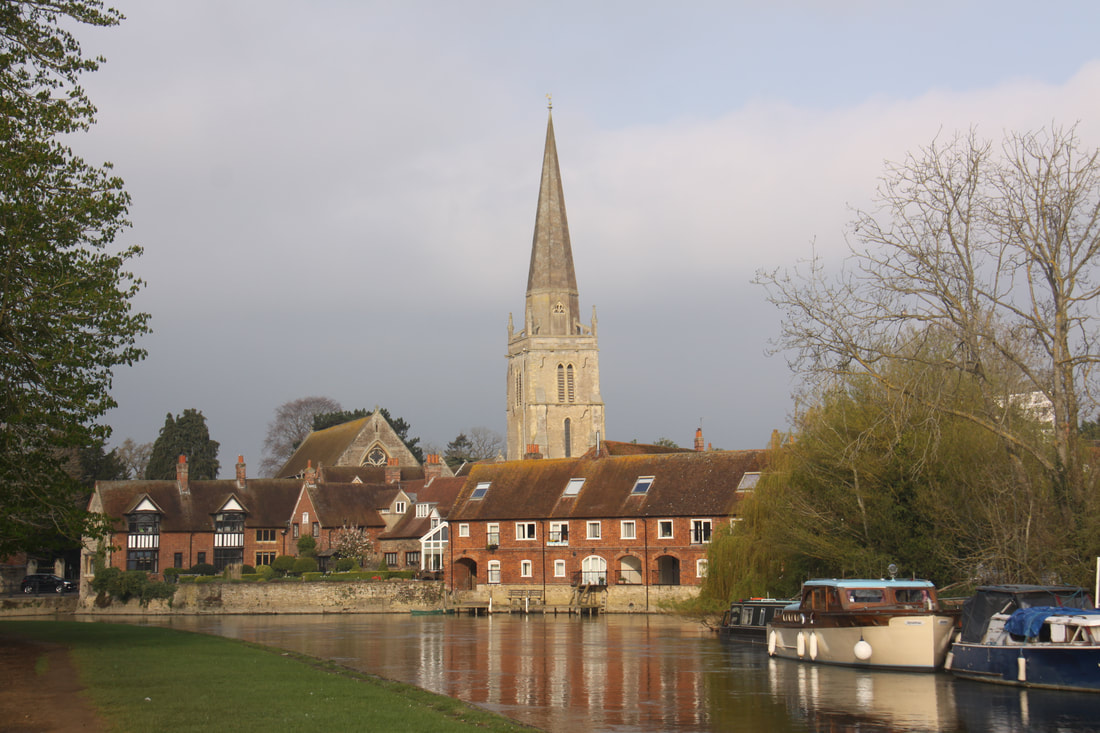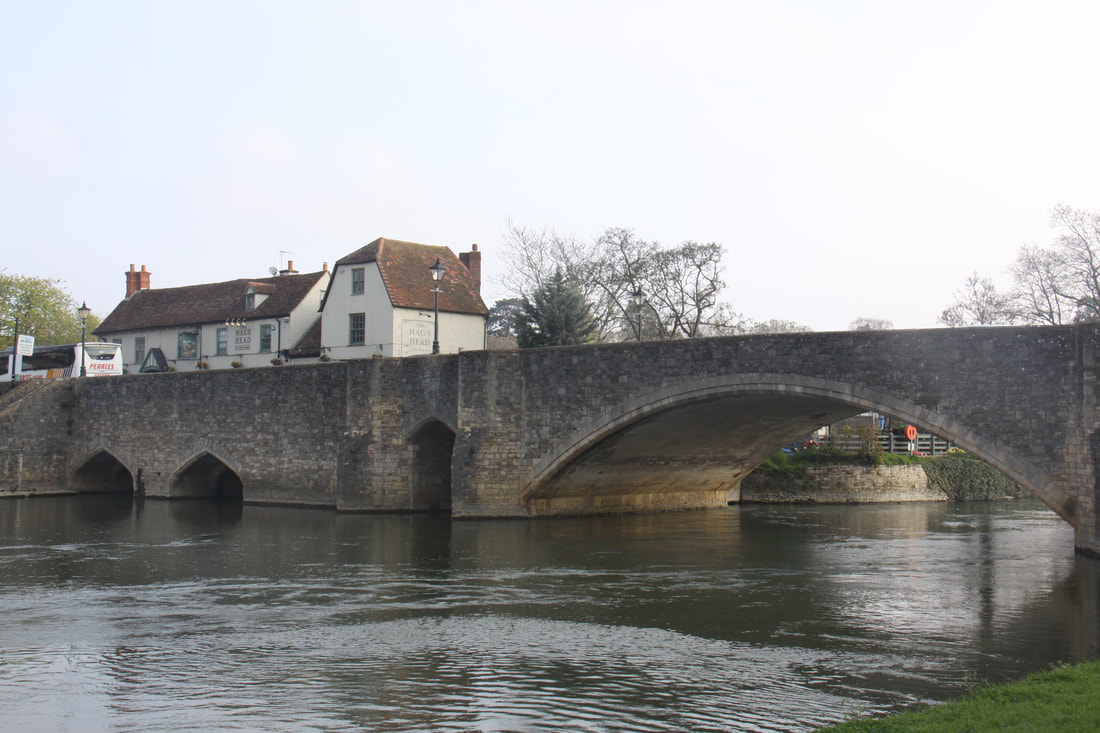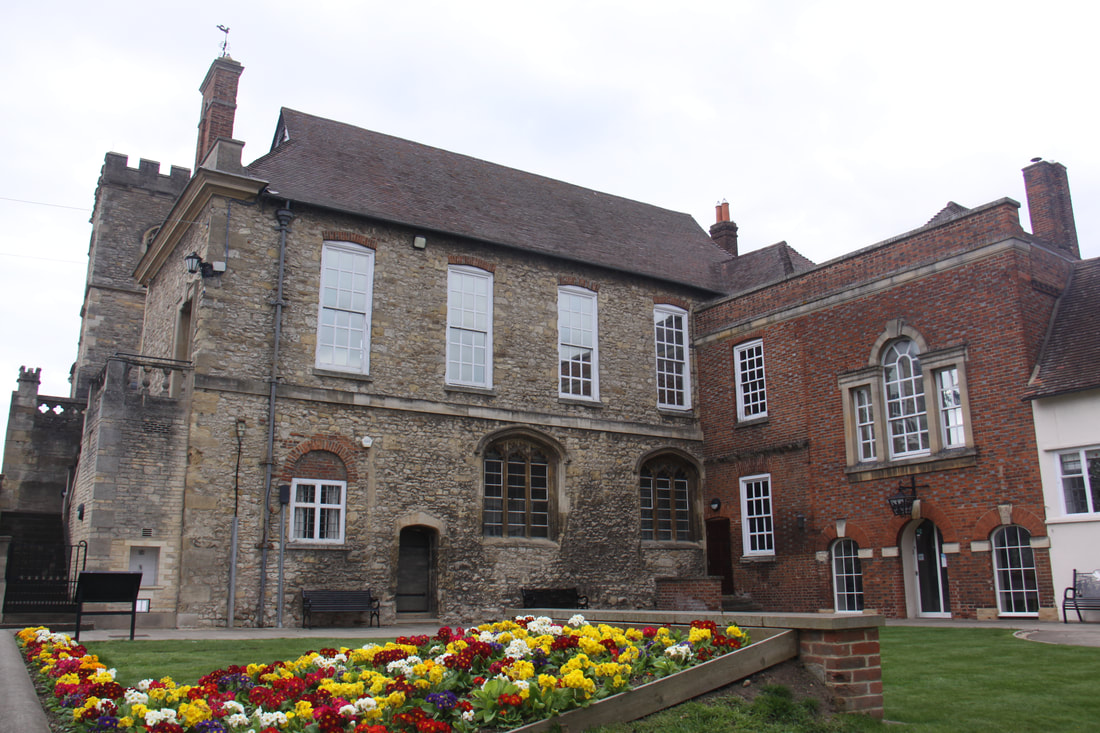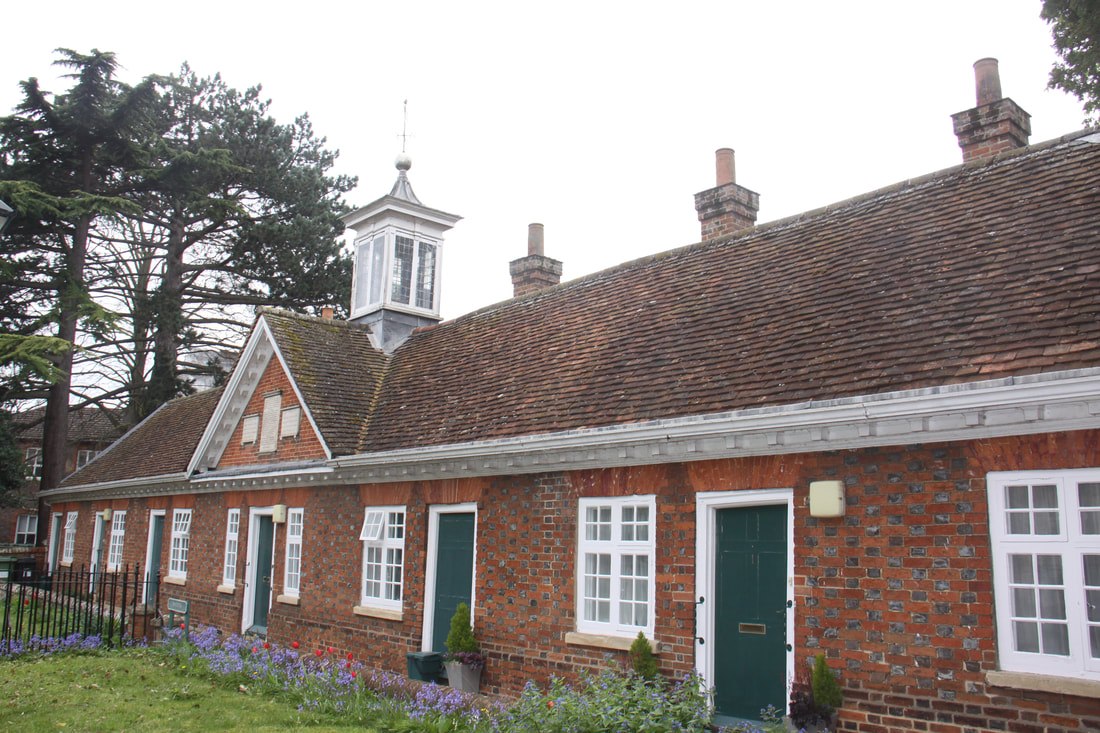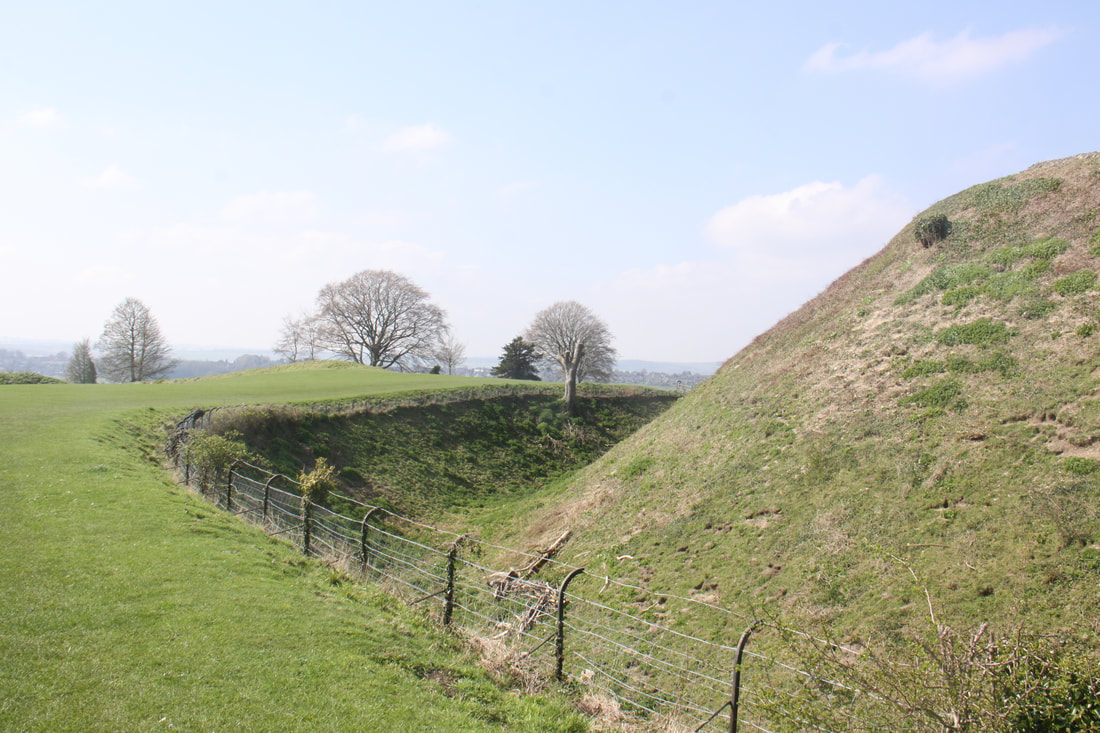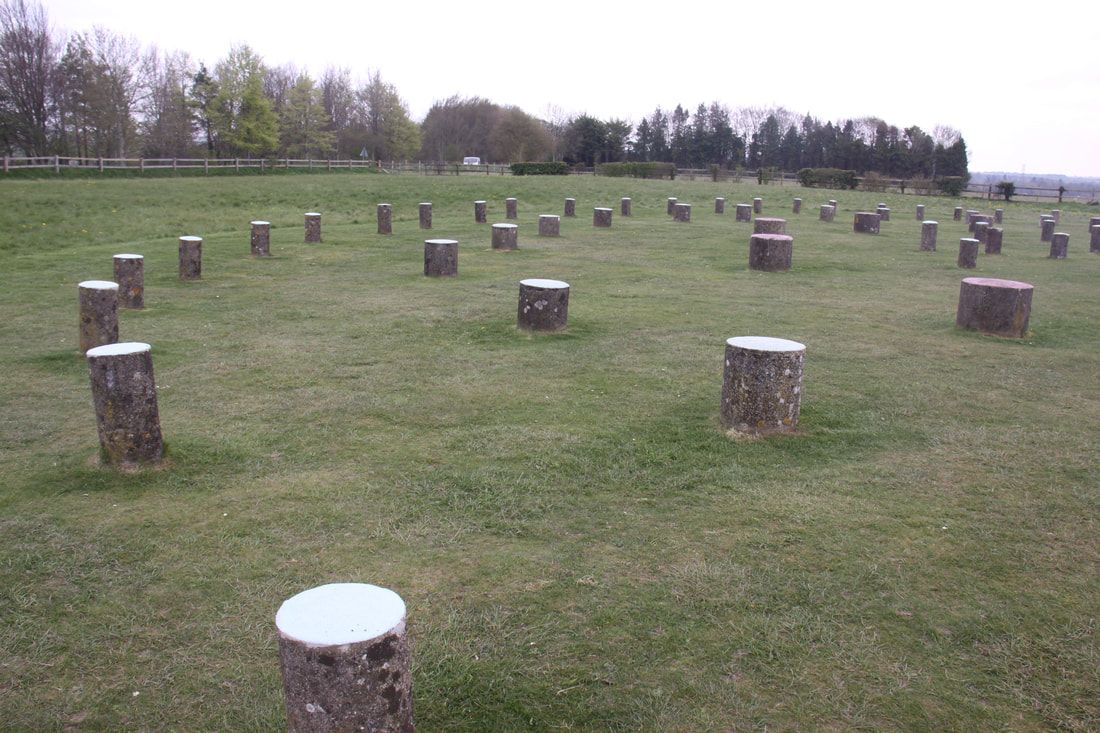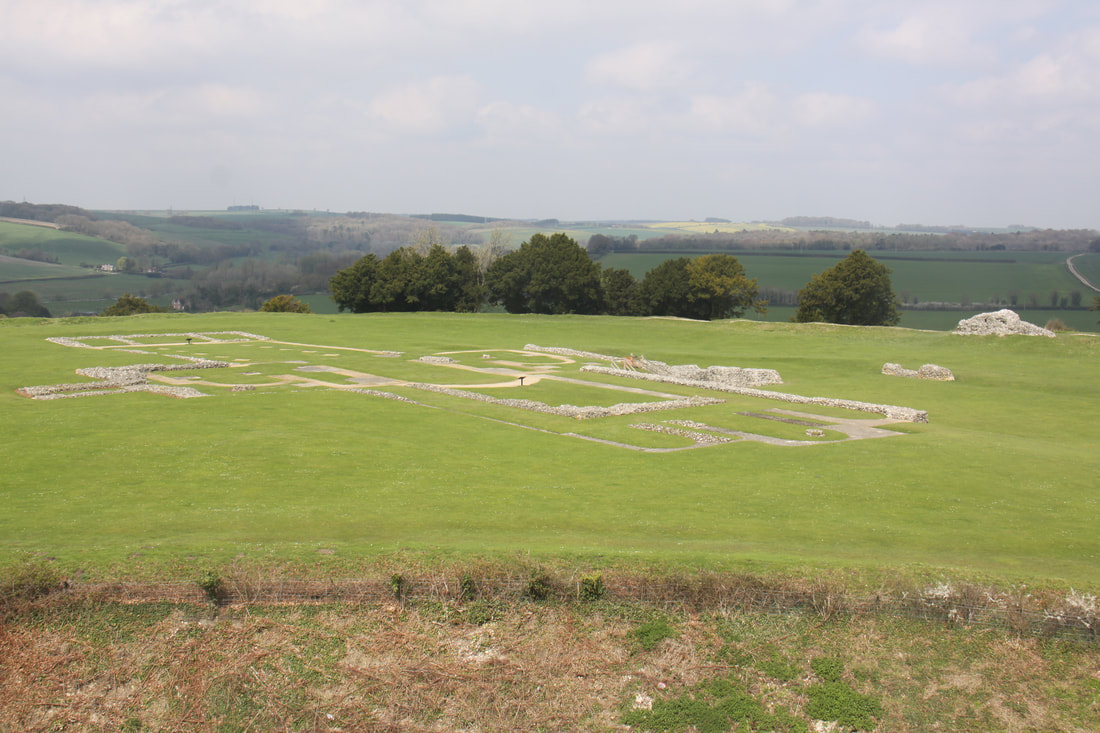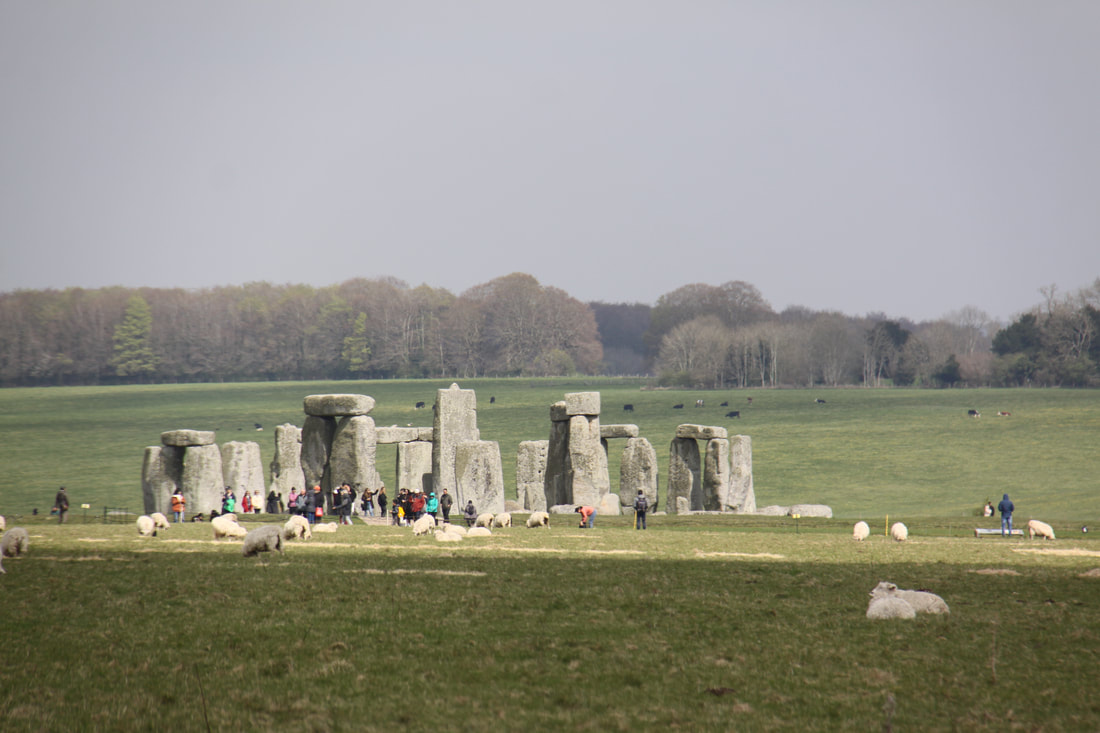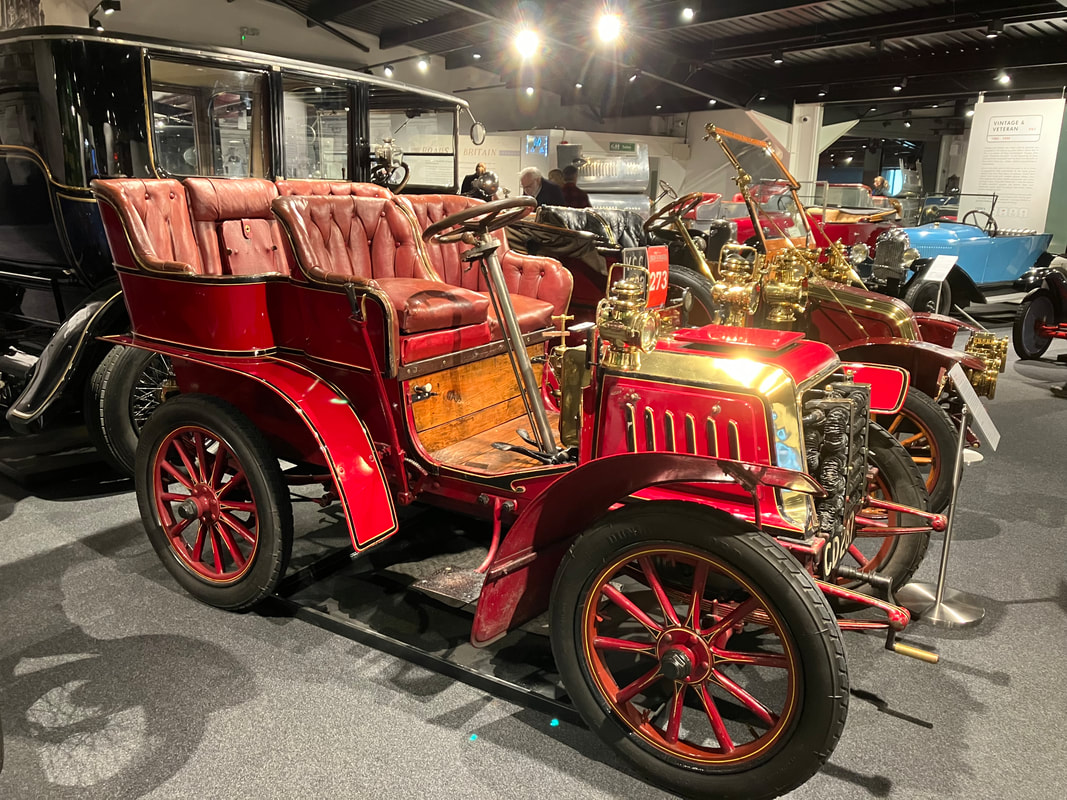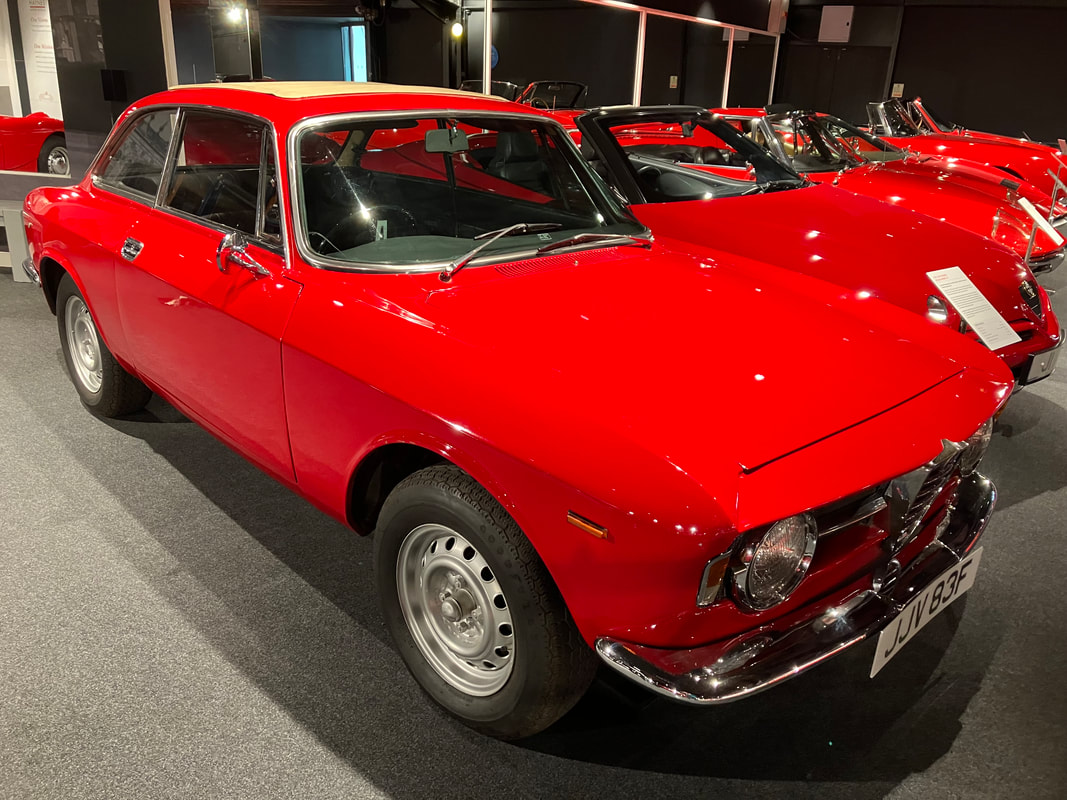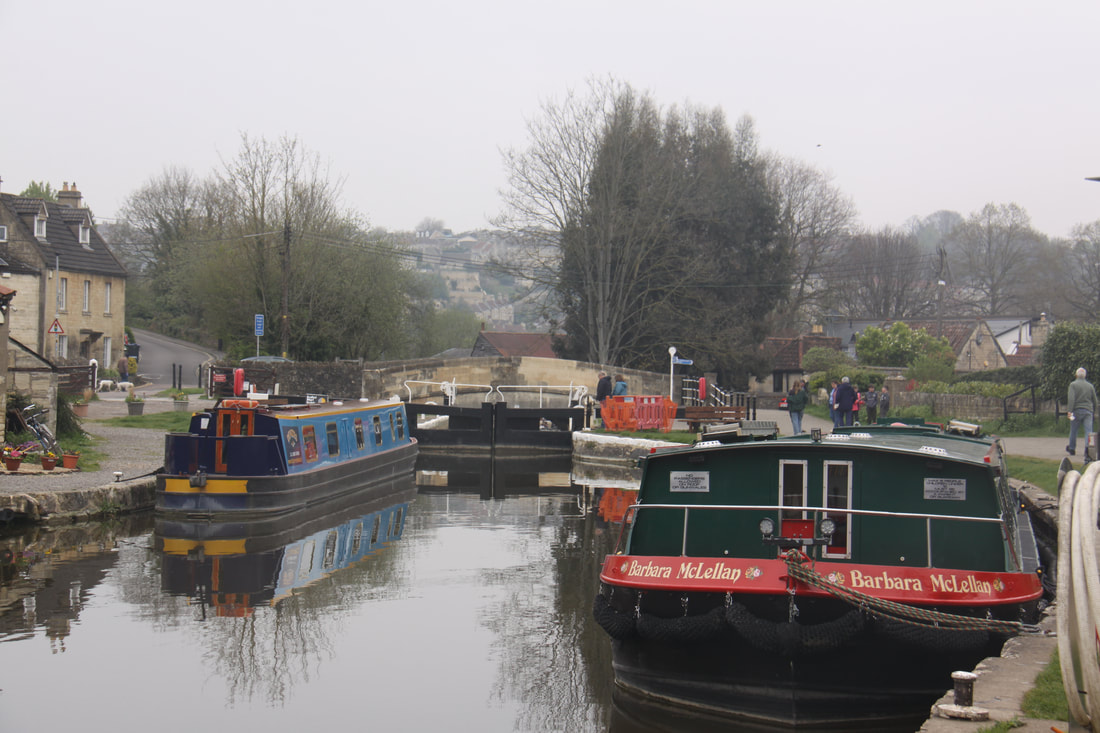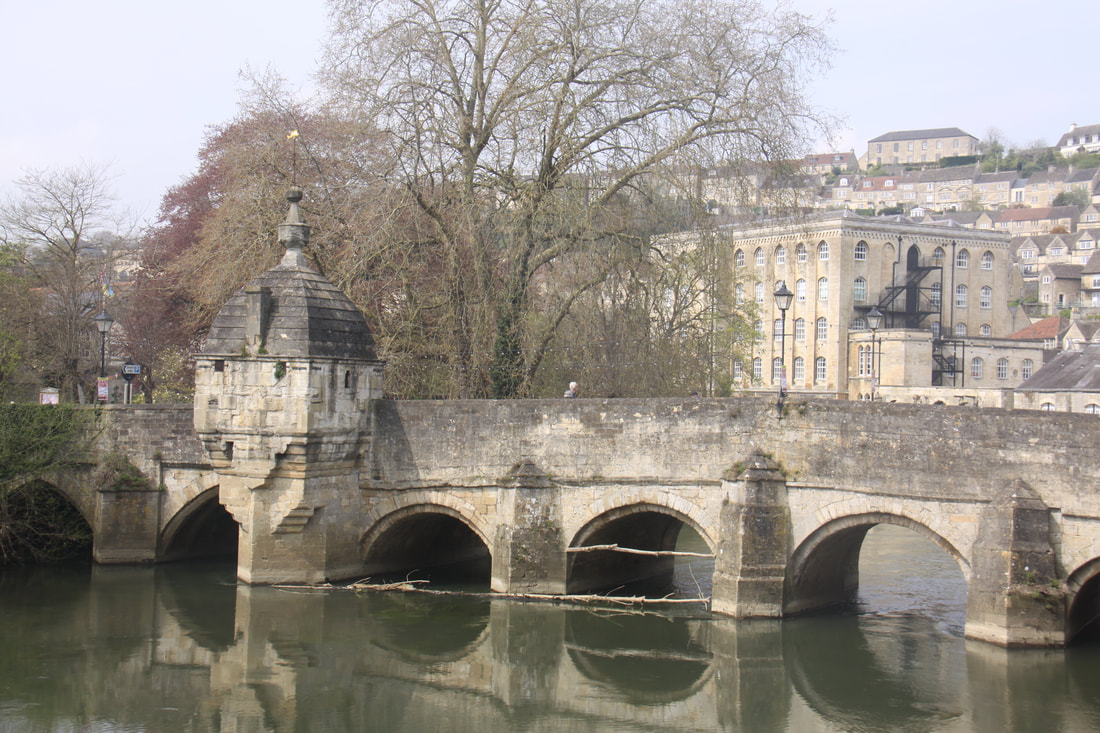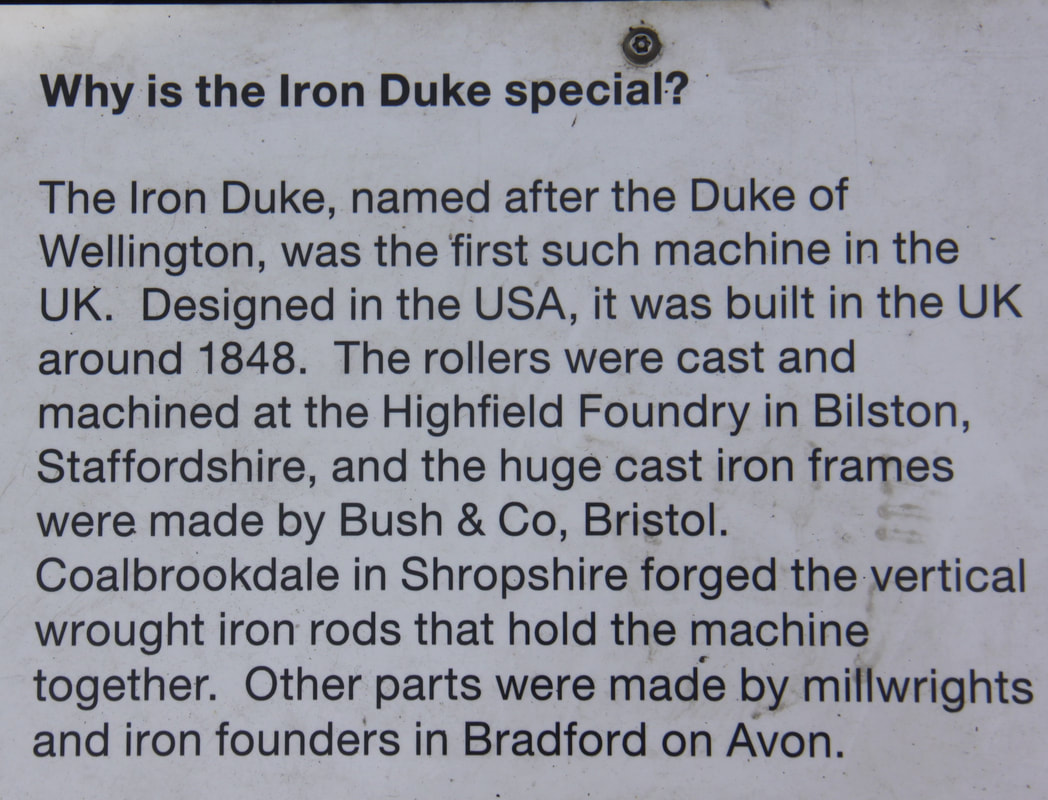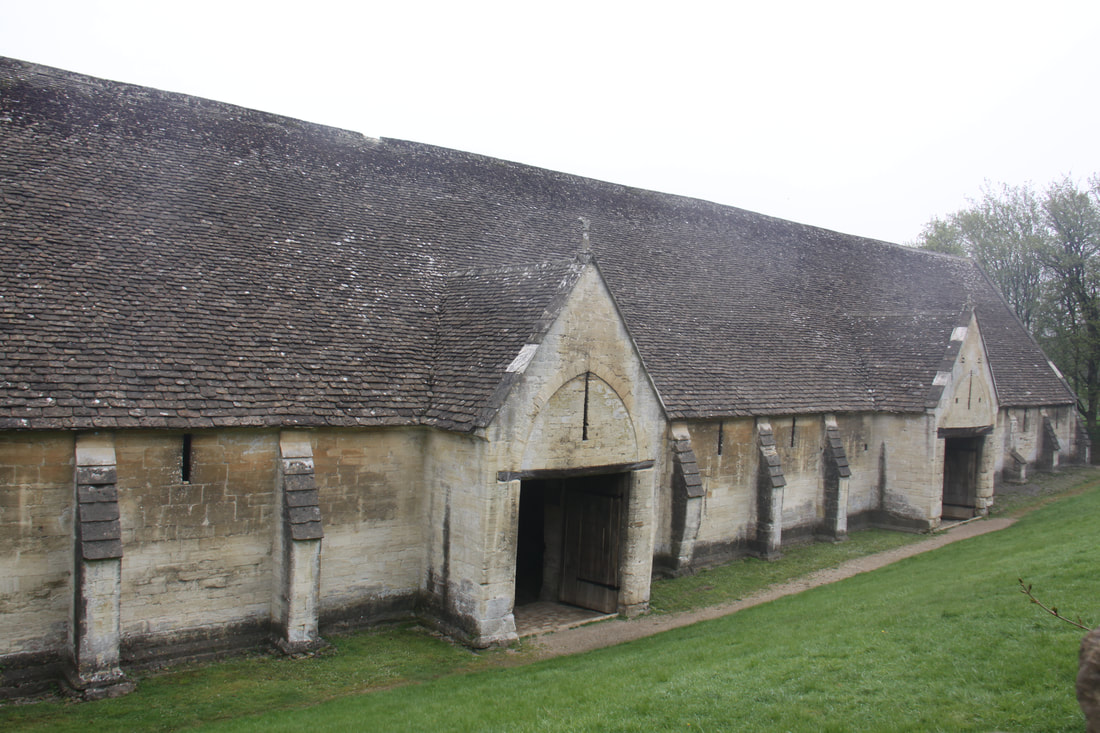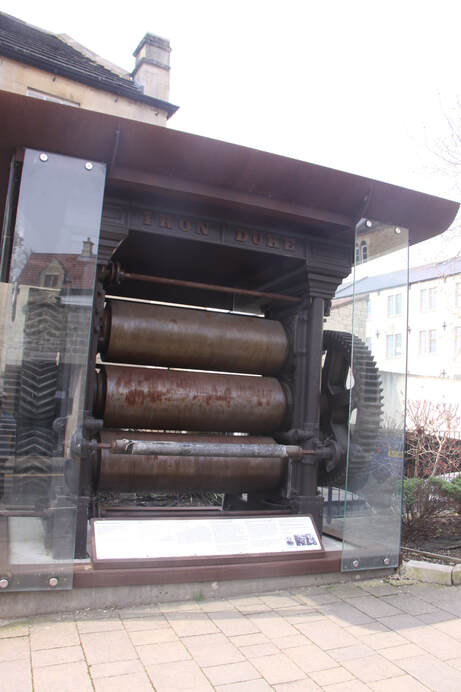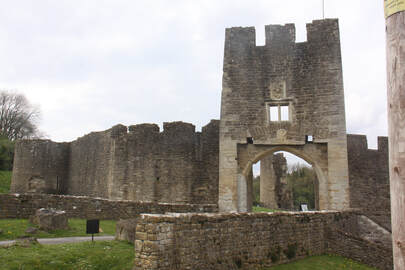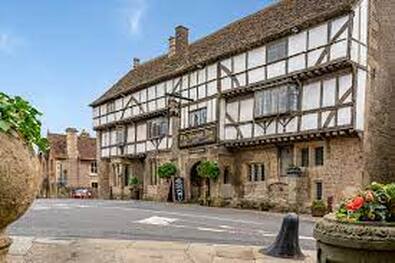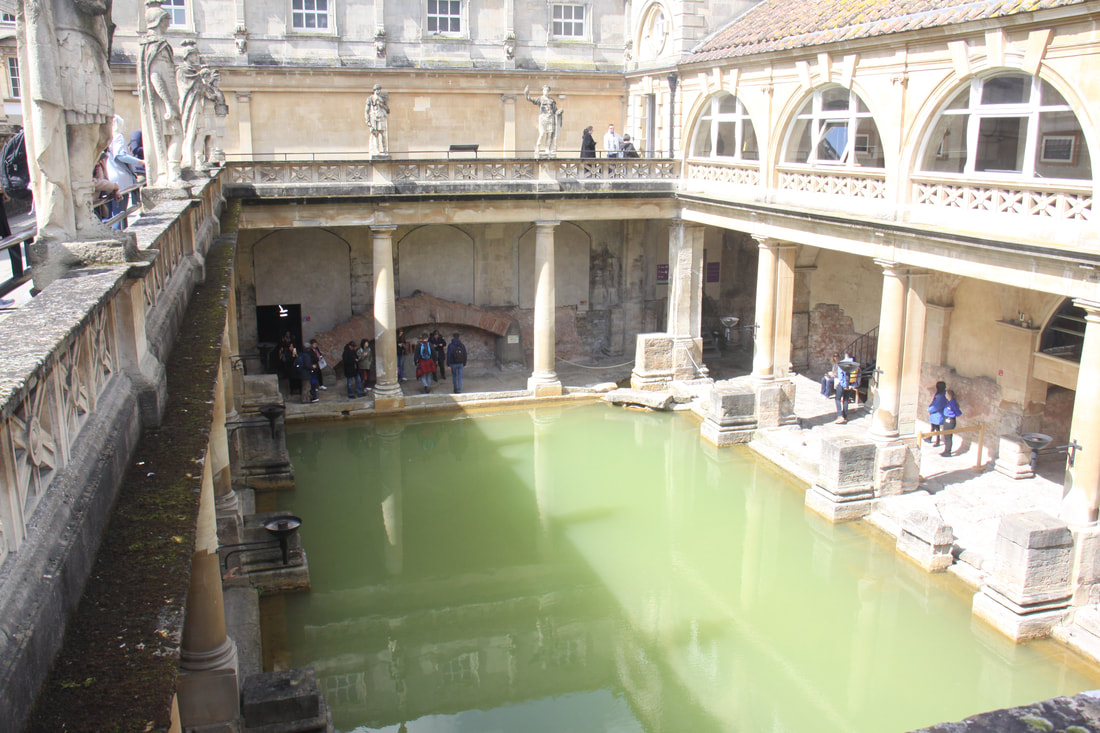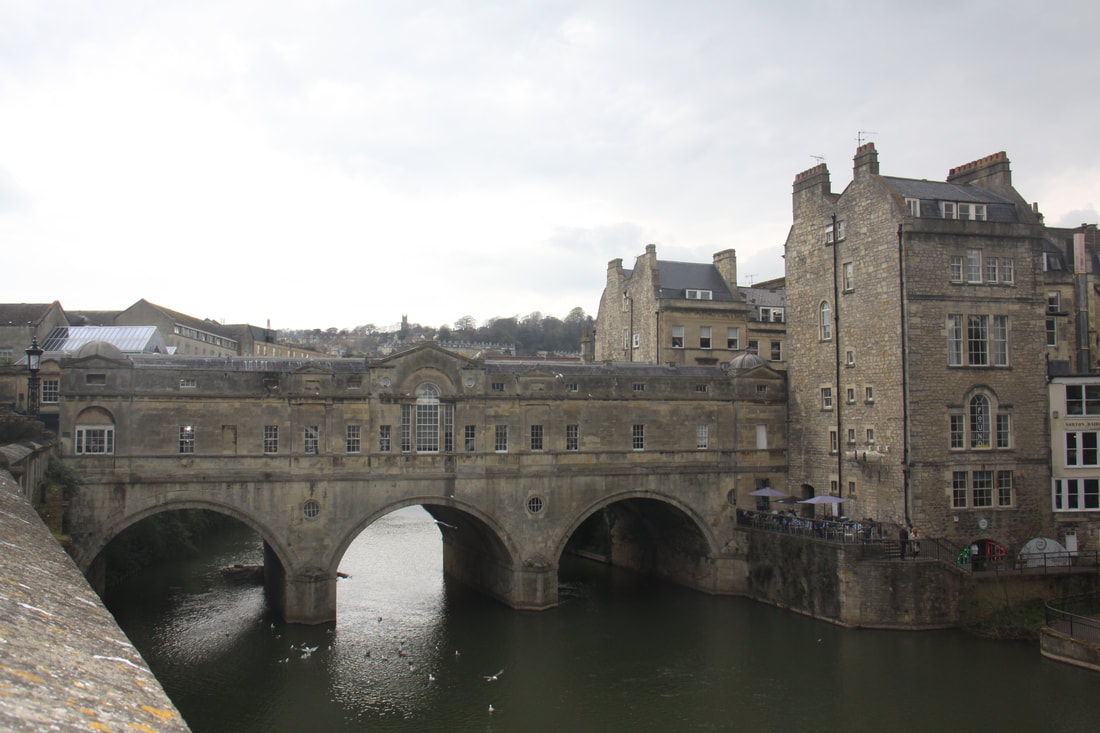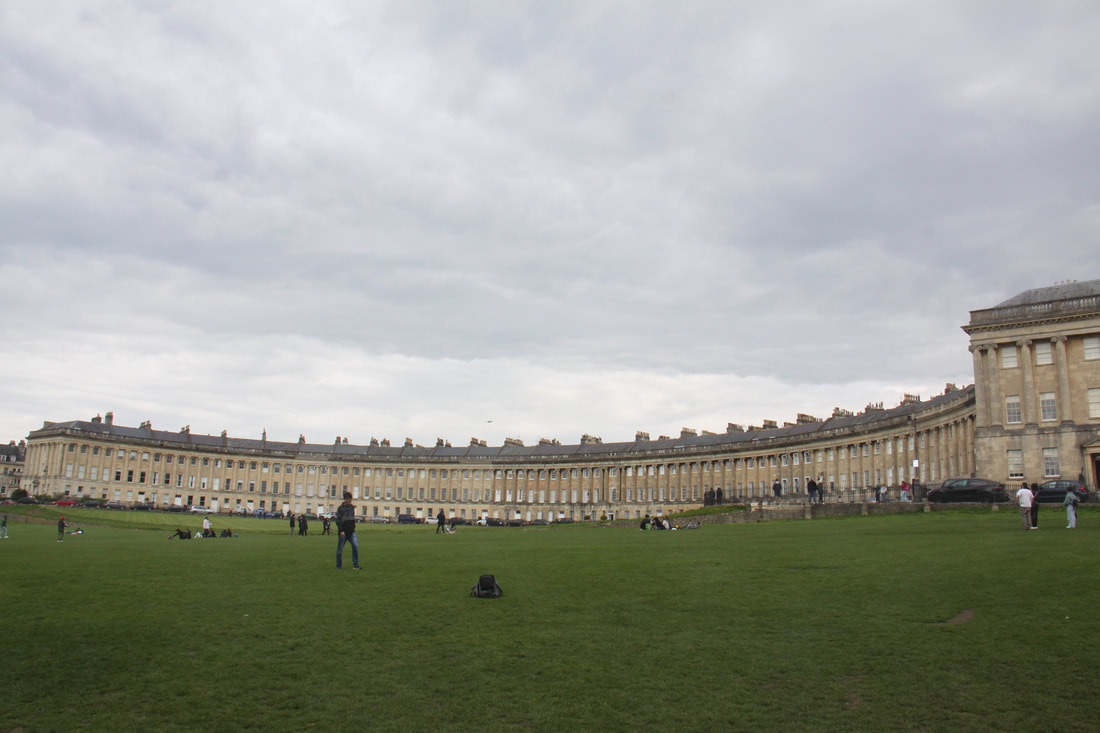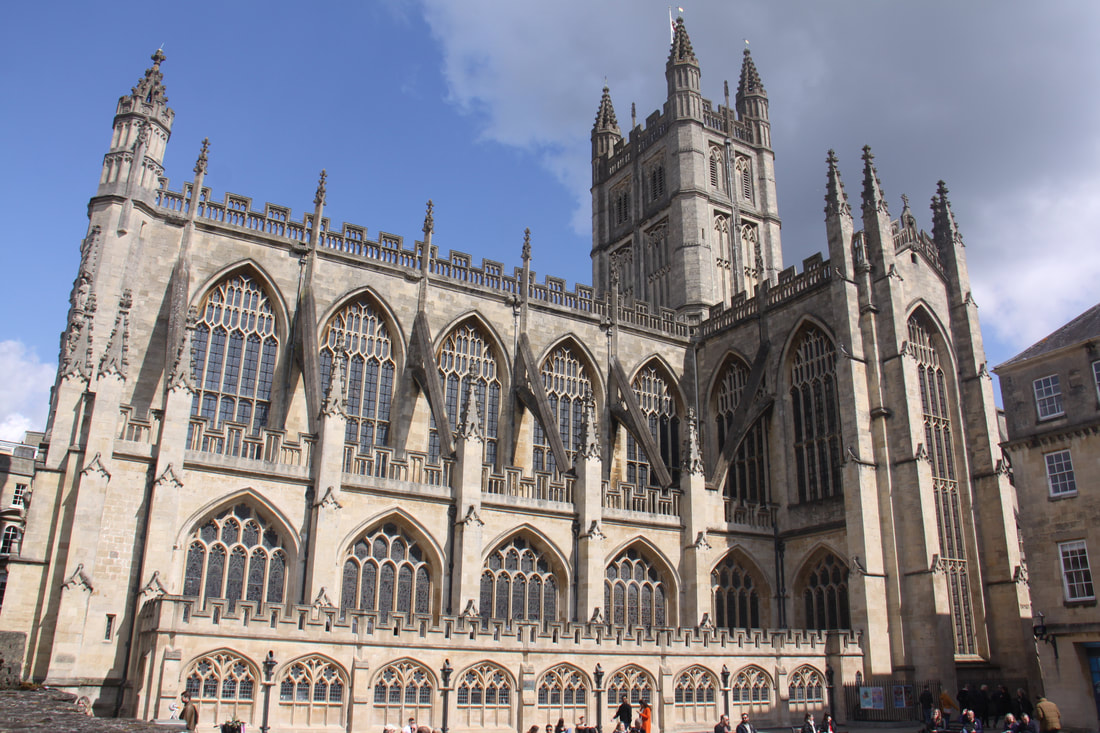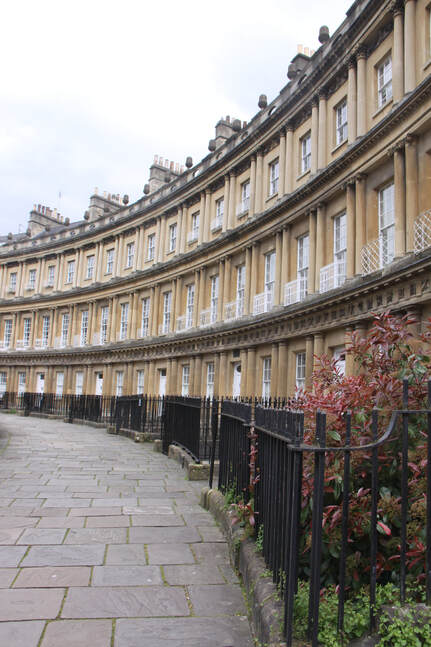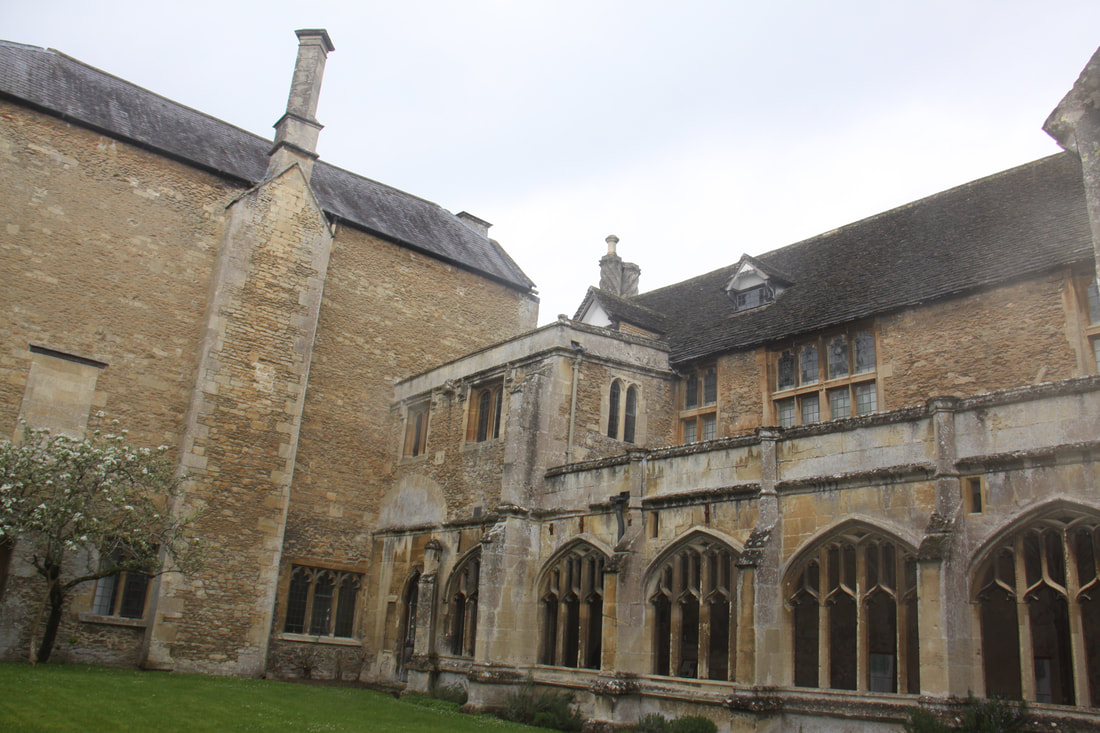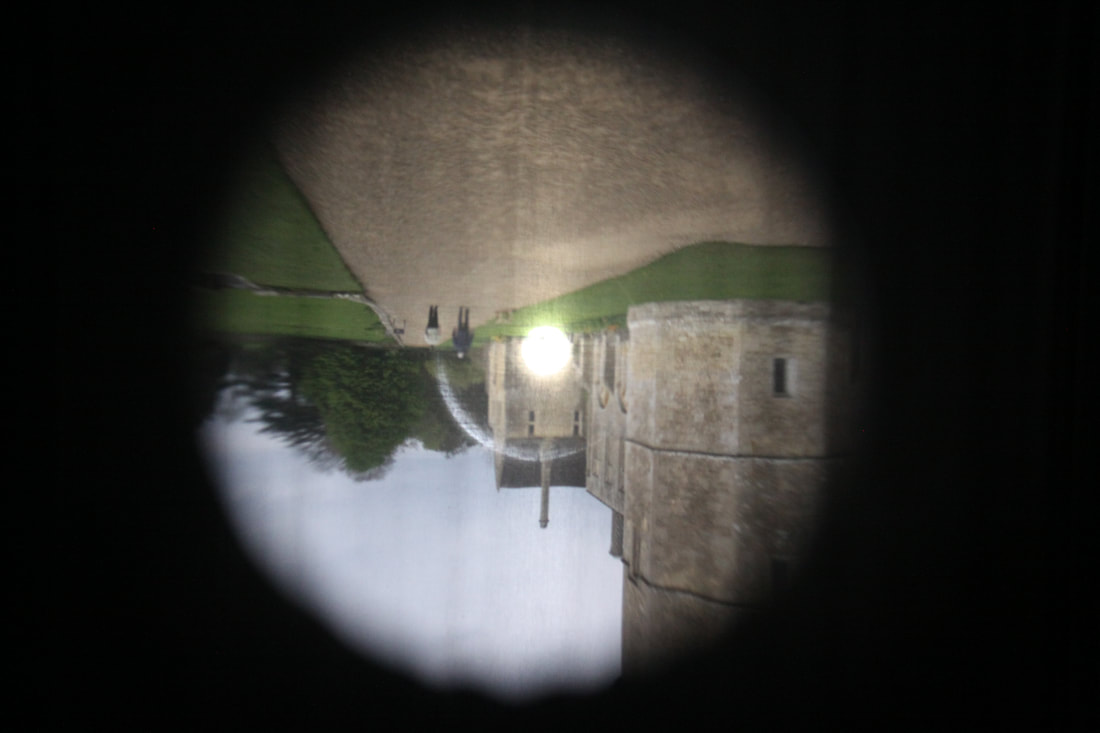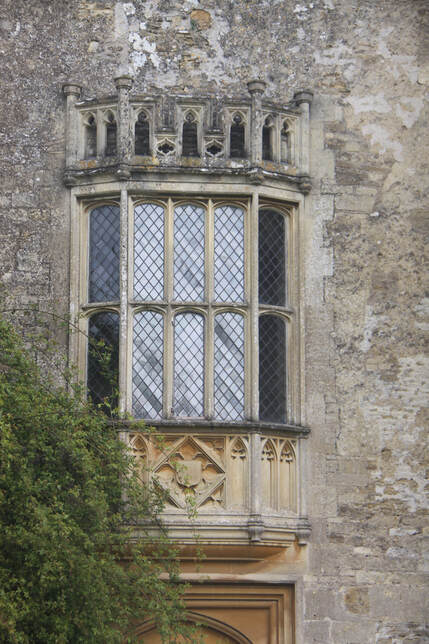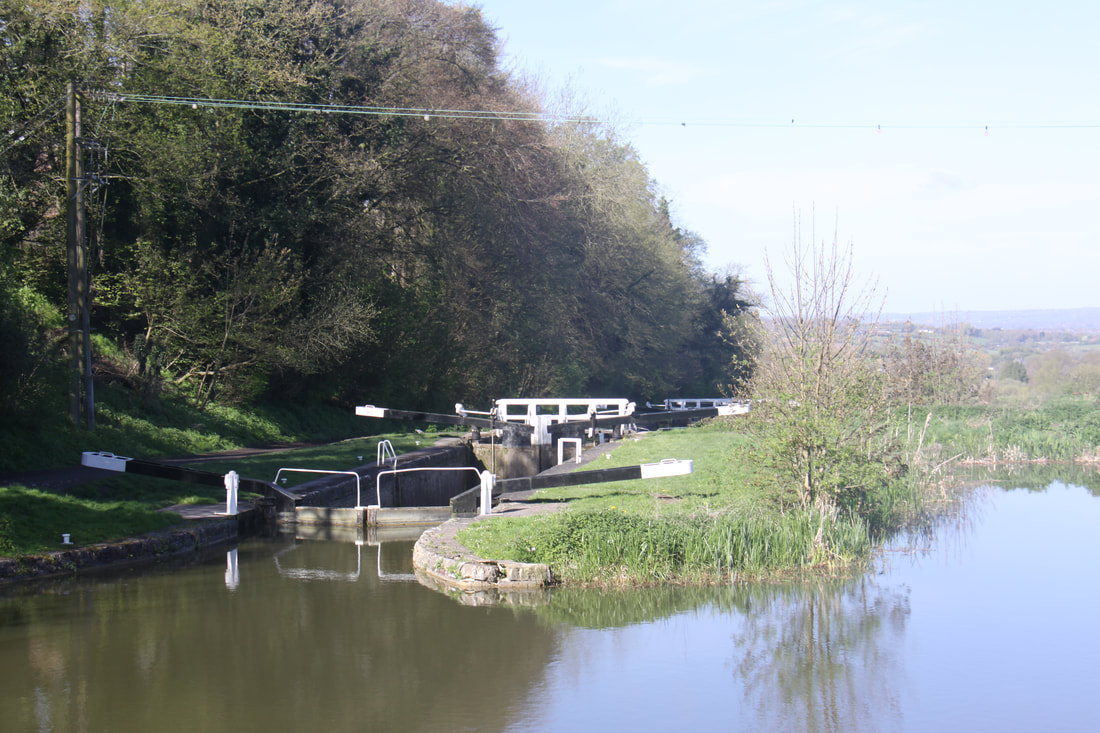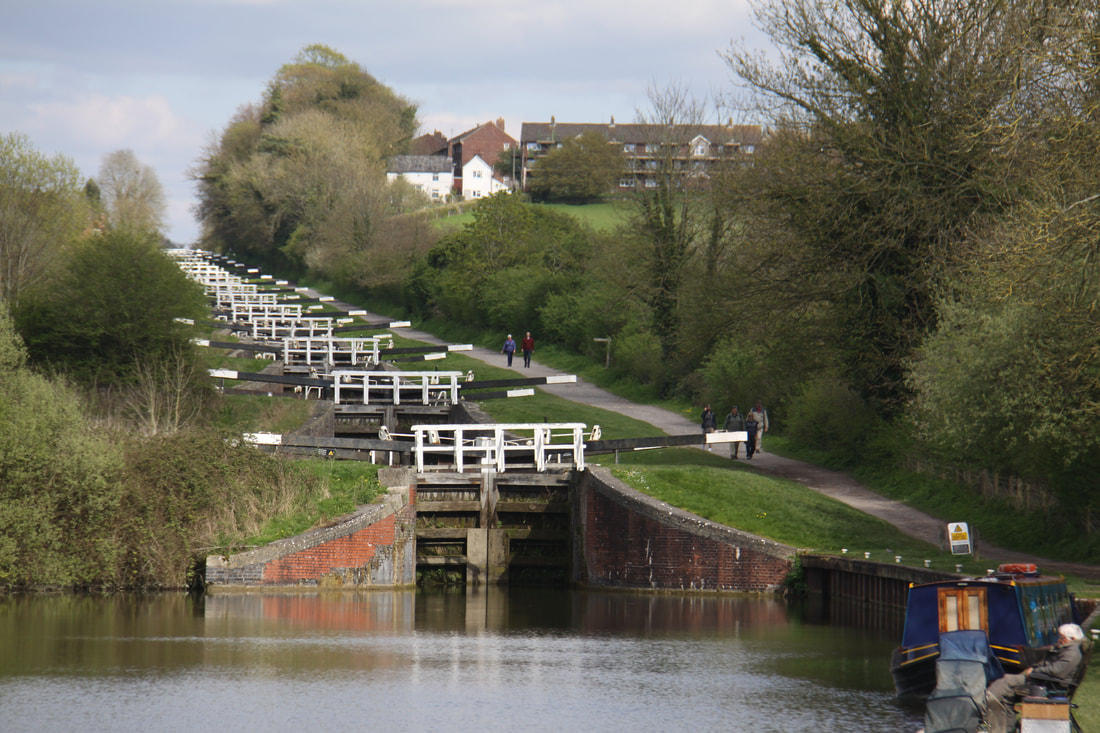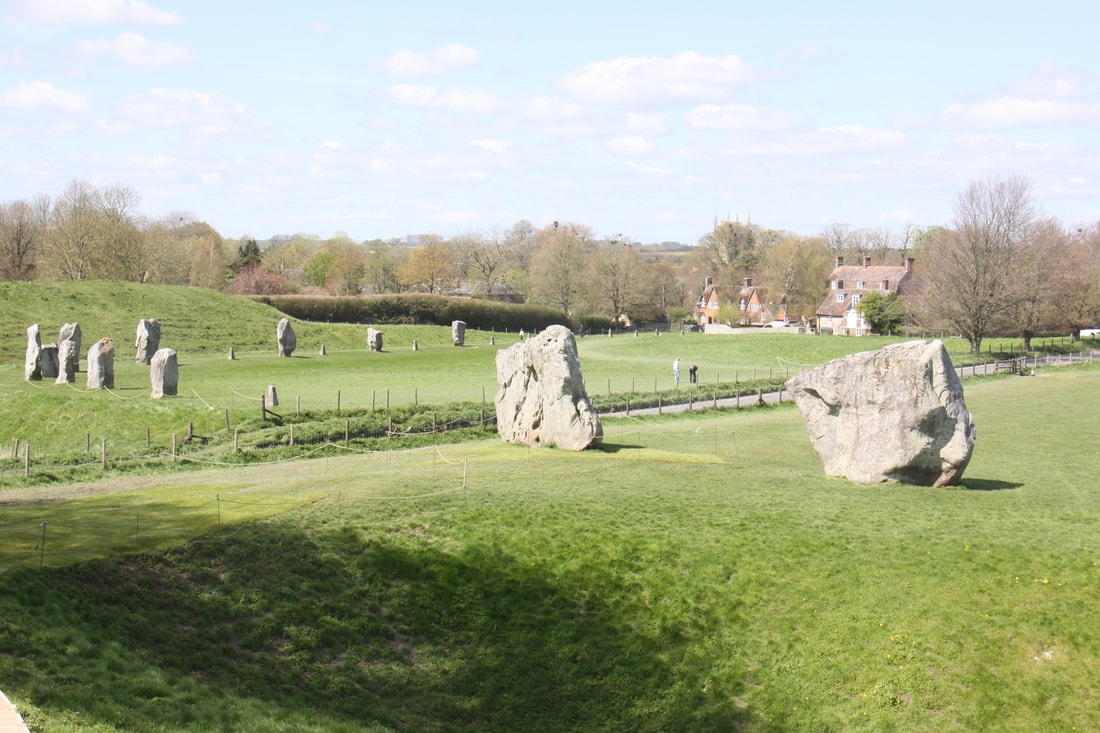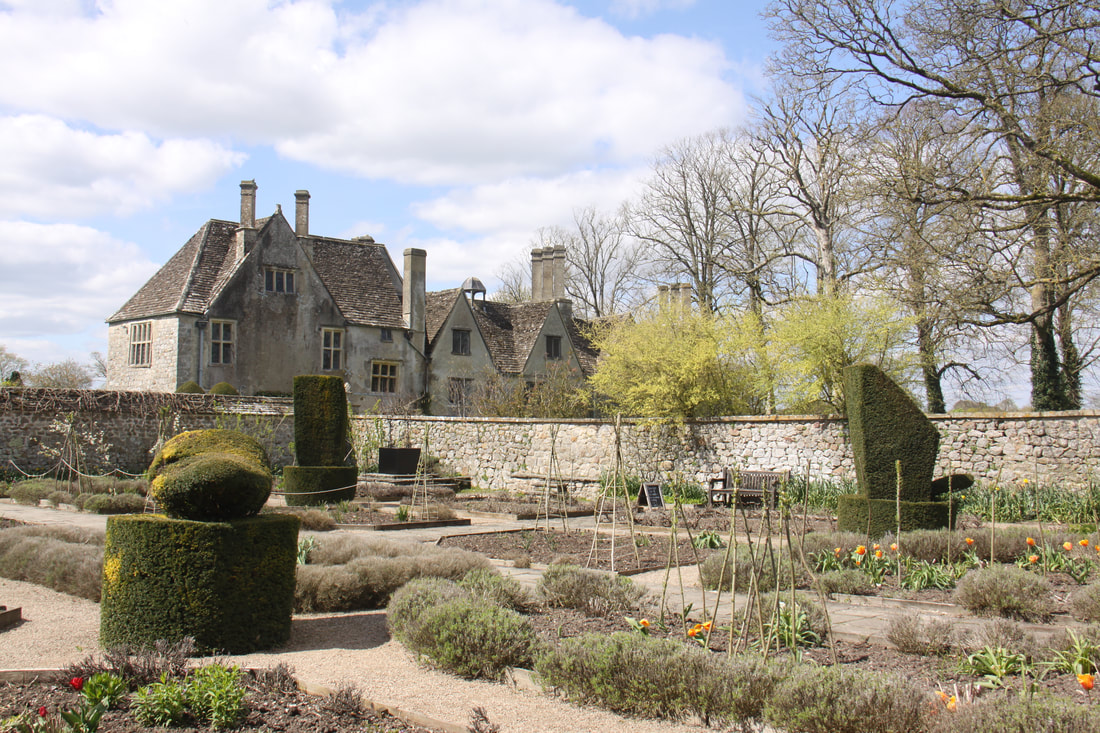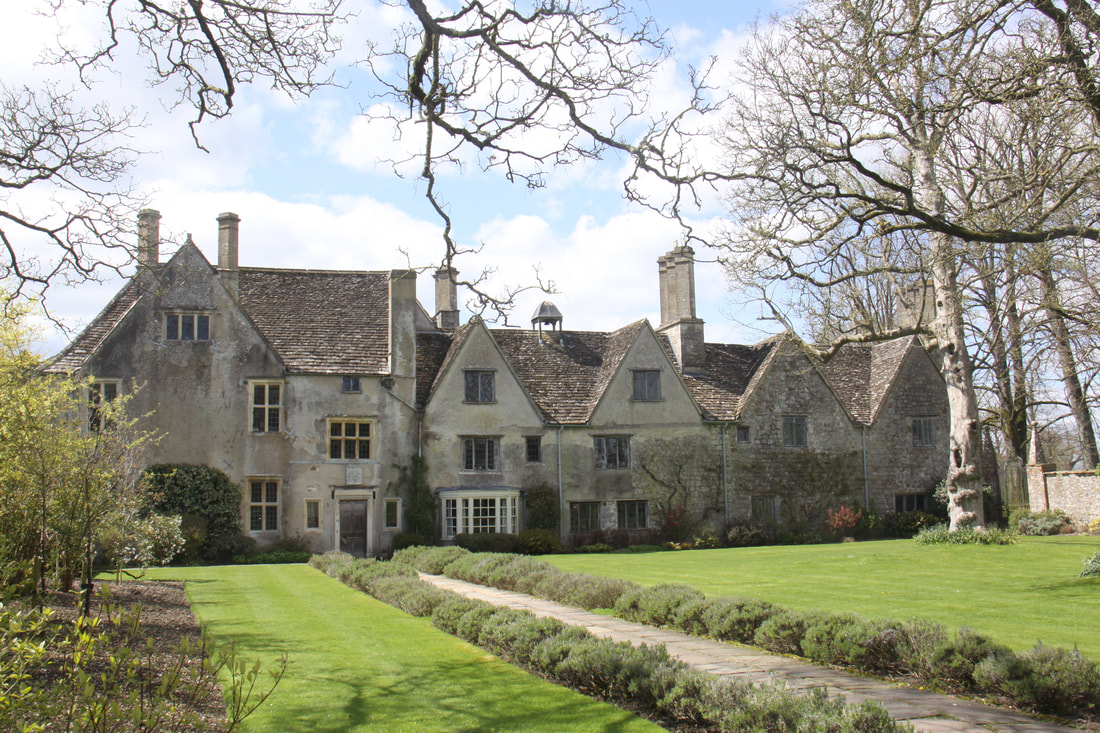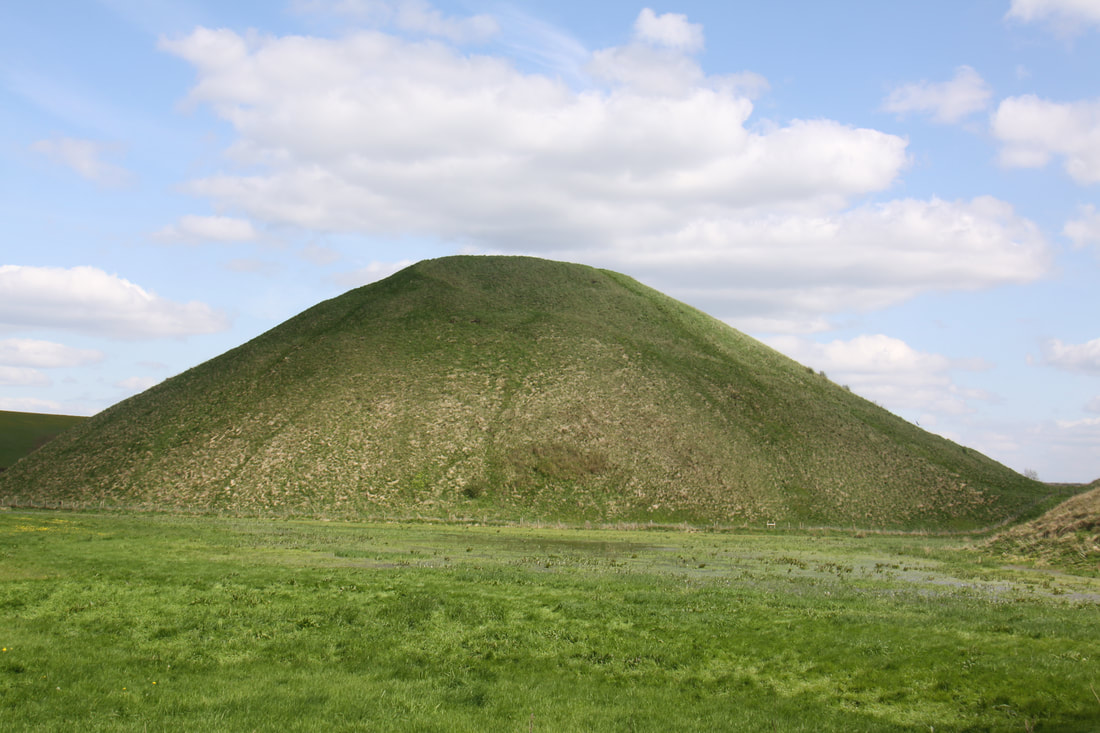West Country 2023
We hadn't been to this area for many years so decided it would make a good trip for our first outing of the year. John lived in Midsomer Norton for two years when he was teaching in Bath, his first teaching job, so was keen to revisit old haunts.
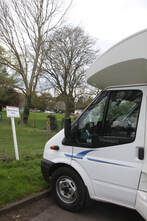
Tuesday 18th April
Drove to Abingdon, a historic town on the river Thames. Car park beside the river allows overnight parking for motorhomes (Britstop SE37). We arrived there with plenty of time to explore this delightful town.
Walked along the Thames footpath with fine views across the river to the town itself. We then crossed the stone bridge built in 1416, into the Market Place with its 17th Century County Hall, St Ncholas Church, Guild Hall, Roysse Court (former grammar school dating from 1256) and the 15th Century Abbey gateway.
Running from the market Place to St. Helen’s Church, East Saint Helen Street, one of the oldest streets in Abingdon, is lined with historic buildings, many dating back to the 15th Century. Three sets of almshouses - the Long Alley, Twittys and Brick Alley - lie along the edge of the grounds of St. Helen’s Church. The Long Alley of 13 houses were built in 1441 with remnants of paintings in the porch from 1605.
Drove to Abingdon, a historic town on the river Thames. Car park beside the river allows overnight parking for motorhomes (Britstop SE37). We arrived there with plenty of time to explore this delightful town.
Walked along the Thames footpath with fine views across the river to the town itself. We then crossed the stone bridge built in 1416, into the Market Place with its 17th Century County Hall, St Ncholas Church, Guild Hall, Roysse Court (former grammar school dating from 1256) and the 15th Century Abbey gateway.
Running from the market Place to St. Helen’s Church, East Saint Helen Street, one of the oldest streets in Abingdon, is lined with historic buildings, many dating back to the 15th Century. Three sets of almshouses - the Long Alley, Twittys and Brick Alley - lie along the edge of the grounds of St. Helen’s Church. The Long Alley of 13 houses were built in 1441 with remnants of paintings in the porch from 1605.
Wednesday 19th April
Visited Old Sarum, Iron Age earthworks constructed around 500BC, now managed by English Heritage.
After 1066 the Norman Conquerors built a royal castle on the inner mound and a cathedral was built between the two concentric earthworks in the mid 12th Century. However, by 1220 Old Sarum went into decline leaving just the bare outlines of the former buildings. Despite this, the setting and scale of the site are truly awe inspiring.
From there, a short drive took us to the remains of Woodhenge and Durrington Walls, both dating back to the late Neolithic period. On our way to our overnight stop at Kimber’s Farm Shop near Wincanton we passed Stonehenge but it was too late in the day to visit.
Visited Old Sarum, Iron Age earthworks constructed around 500BC, now managed by English Heritage.
After 1066 the Norman Conquerors built a royal castle on the inner mound and a cathedral was built between the two concentric earthworks in the mid 12th Century. However, by 1220 Old Sarum went into decline leaving just the bare outlines of the former buildings. Despite this, the setting and scale of the site are truly awe inspiring.
From there, a short drive took us to the remains of Woodhenge and Durrington Walls, both dating back to the late Neolithic period. On our way to our overnight stop at Kimber’s Farm Shop near Wincanton we passed Stonehenge but it was too late in the day to visit.
Thursday 20th April
Spent today at the Haynes International Motor Museum in Sparkford.
John Haynes wrote his first Workshop Manuel when he was 16, from the notes he made when he built an Austin 7 special, and sold it for 5 shillings. That was the start of his publishing empire. With the money he made he built up a car collection which became the world famous museum as we see today. An incredible collection of vehicles from around the world dating back to the earliest days of motoring. Special exhibitions featured the mini, American cars and a recreation of the original Morris Garage which later became MG. There was also a huge collection of red cars. We especially enjoyed the collection of everyday British cars of the 50’s, 60’s and 70’s featuring many cars that we and our parents had owned.
Spent today at the Haynes International Motor Museum in Sparkford.
John Haynes wrote his first Workshop Manuel when he was 16, from the notes he made when he built an Austin 7 special, and sold it for 5 shillings. That was the start of his publishing empire. With the money he made he built up a car collection which became the world famous museum as we see today. An incredible collection of vehicles from around the world dating back to the earliest days of motoring. Special exhibitions featured the mini, American cars and a recreation of the original Morris Garage which later became MG. There was also a huge collection of red cars. We especially enjoyed the collection of everyday British cars of the 50’s, 60’s and 70’s featuring many cars that we and our parents had owned.
Friday 21st April
A wet, cold, windy day. We were booked onto the Camping and Caravanning Club Site at Devizes. Arrived there at 1.00 pm and booked onto our pitch – we had opted for a grass pitch, not the best of ideas considering the weather! We had hoped for a walk along the canal towpath but there was further rain during the afternoon and the path was very muddy.
Saturday 22nd April
After leaving the campsite it was a short drive to Bradford on Avon. A short walk from the car park, along the Kennet and Avon Canal towpath, took us into the town. We stopped at the lock to watch a boat descend.
A little further on was Barton Farm with its impressive, mid 14th C tithe barn. With a length of 167 feet and width of 30 feet, it is one of the largest and most important barns in England.
We then walked along the river Avon with extensive views across the honey coloured stone buildings perched one above the other up the steep valley sides. We crossed the stone bridge with its picturesque arches and small chapel into the centre of the town. The Shambles, a small narrow street gave us a glimpse into what the town would have looked like in the past. On display is the “Iron Duke”, a huge piece of industrial architecture which was used to provide waterproof capes and boots for soldiers in the Crimean War.
A wet, cold, windy day. We were booked onto the Camping and Caravanning Club Site at Devizes. Arrived there at 1.00 pm and booked onto our pitch – we had opted for a grass pitch, not the best of ideas considering the weather! We had hoped for a walk along the canal towpath but there was further rain during the afternoon and the path was very muddy.
Saturday 22nd April
After leaving the campsite it was a short drive to Bradford on Avon. A short walk from the car park, along the Kennet and Avon Canal towpath, took us into the town. We stopped at the lock to watch a boat descend.
A little further on was Barton Farm with its impressive, mid 14th C tithe barn. With a length of 167 feet and width of 30 feet, it is one of the largest and most important barns in England.
We then walked along the river Avon with extensive views across the honey coloured stone buildings perched one above the other up the steep valley sides. We crossed the stone bridge with its picturesque arches and small chapel into the centre of the town. The Shambles, a small narrow street gave us a glimpse into what the town would have looked like in the past. On display is the “Iron Duke”, a huge piece of industrial architecture which was used to provide waterproof capes and boots for soldiers in the Crimean War.
On route to our overnight stop, a farm in Farrington Gurney, we stopped at Hungerford Castle at Farleigh. Originally a fortified manor dating from the 1370’s, it was extended in the 15th C. Now largely in ruins but the medieval chapel is still intact with impressive wall paintings and a complete crypt.
We passed the Grade 1 listed George Inn at Norton St Phillip where John and his sister often spent a Friday evening when they lived there fifty years ago and drove through Midsomer Norton where they lived.
We had planned on fish and chips for supper tonight but regrettably there had been a fire at the Fish Shop and they were out of action. Fortunately the farm shop was still open and they had a delicious quiche and local cheese and cider so we managed a tasty meal after all.
We passed the Grade 1 listed George Inn at Norton St Phillip where John and his sister often spent a Friday evening when they lived there fifty years ago and drove through Midsomer Norton where they lived.
We had planned on fish and chips for supper tonight but regrettably there had been a fire at the Fish Shop and they were out of action. Fortunately the farm shop was still open and they had a delicious quiche and local cheese and cider so we managed a tasty meal after all.
Sunday 23rd April
Drive It Day, organised by the Federation of British Historic Vehicle Clubs, and the farm at Farrington Gurney were hosting a meet. Wandered round admiring the cars before heading to Bath for the day.
A Park and Ride service took us into the centre of Bath and we headed for the Roman Baths. There were long queues and various areas for different timed tickets. Obviously you are supposed to book on line! Staff supervising the queues took pity on us and fast tracked us into the Baths.
We had both visited the Roman Baths, separately, long before we met, many, many years ago. The site is much bigger now with displays and a museum. The main change of course is that you can’t get too close to the water. On our previous visit you could swim in the Baths!
The audio tour was very detailed and really brought the incredibly well preserved Baths alive. Before reaching the main bathing area, a series of room displays explained how the site was laid out and how the people of the town lived and used the bathing complex.
After a late lunch we walked round the Abbey and down to the river Avon. The Grade 1 listed Pulteney Bridge, built in 1774, straddles the river and is highly unusual in that it has shops built across its full span on both sides.
A steep uphill walk took us to The Circus, fine Georgian houses surround a central grass area, and on to the magnificent Royal Crescent overlooking the Royal Victoria Park. Taking the bus back to the Park and Ride we passed the “Rec”, Bath’s famous rugby club. John played for Midsomer Norton but had once played on Bath’s first team pitch in a seven a side tournament.
On our way back to Farrington Gurney we passed Bury View Campsite. John lived there for a while in his caravan, paying 10 shillings a week! Several mobile homes parked there suggested that others were still doing likewise.
Drive It Day, organised by the Federation of British Historic Vehicle Clubs, and the farm at Farrington Gurney were hosting a meet. Wandered round admiring the cars before heading to Bath for the day.
A Park and Ride service took us into the centre of Bath and we headed for the Roman Baths. There were long queues and various areas for different timed tickets. Obviously you are supposed to book on line! Staff supervising the queues took pity on us and fast tracked us into the Baths.
We had both visited the Roman Baths, separately, long before we met, many, many years ago. The site is much bigger now with displays and a museum. The main change of course is that you can’t get too close to the water. On our previous visit you could swim in the Baths!
The audio tour was very detailed and really brought the incredibly well preserved Baths alive. Before reaching the main bathing area, a series of room displays explained how the site was laid out and how the people of the town lived and used the bathing complex.
After a late lunch we walked round the Abbey and down to the river Avon. The Grade 1 listed Pulteney Bridge, built in 1774, straddles the river and is highly unusual in that it has shops built across its full span on both sides.
A steep uphill walk took us to The Circus, fine Georgian houses surround a central grass area, and on to the magnificent Royal Crescent overlooking the Royal Victoria Park. Taking the bus back to the Park and Ride we passed the “Rec”, Bath’s famous rugby club. John played for Midsomer Norton but had once played on Bath’s first team pitch in a seven a side tournament.
On our way back to Farrington Gurney we passed Bury View Campsite. John lived there for a while in his caravan, paying 10 shillings a week! Several mobile homes parked there suggested that others were still doing likewise.
Monday 24th April
The weather had changed for the worst and it was a case of dodging the heavy showers A short drive took us to Laycock. The last time we’d tried to visit it had heaved down all day and we gave up. Today was a little better.
We wandered through the grounds to the Abbey. Originally a Nunnery, it was founded in 1232 by Ela of Salisbury. The medieval cloisters very well preserved – it was used in the Harry Potter films. Part of the original nunnery was turned into a family home. Today it is shown as it was when William Henry Fox Talbot who invented the photographic negative in 1855 lived there. In the Abbey grounds we visited the camera obscura and viewed the inverted negative just as Fox Talbot had taken. It was then obligatory to take a modern photo of the same oriel window!
We had a quick look in at the Fox Talbot Museum before walking through part of Laycock village. Unfortunately all the beautiful old houses had modern cars parked in front of them, spoiling any opportunity of any decent photos.
A nearby pub was in the BritStops book but when we phoned no-one answered. Driving past we discovered that it was very definitely closed down. Drove onto the Camping and Caravanning Club site at Devizes and fortunately they had space for us on a hard standing pitch. The grass pitches were out of action because of the weather. We booked in for two nights.
The weather had changed for the worst and it was a case of dodging the heavy showers A short drive took us to Laycock. The last time we’d tried to visit it had heaved down all day and we gave up. Today was a little better.
We wandered through the grounds to the Abbey. Originally a Nunnery, it was founded in 1232 by Ela of Salisbury. The medieval cloisters very well preserved – it was used in the Harry Potter films. Part of the original nunnery was turned into a family home. Today it is shown as it was when William Henry Fox Talbot who invented the photographic negative in 1855 lived there. In the Abbey grounds we visited the camera obscura and viewed the inverted negative just as Fox Talbot had taken. It was then obligatory to take a modern photo of the same oriel window!
We had a quick look in at the Fox Talbot Museum before walking through part of Laycock village. Unfortunately all the beautiful old houses had modern cars parked in front of them, spoiling any opportunity of any decent photos.
A nearby pub was in the BritStops book but when we phoned no-one answered. Driving past we discovered that it was very definitely closed down. Drove onto the Camping and Caravanning Club site at Devizes and fortunately they had space for us on a hard standing pitch. The grass pitches were out of action because of the weather. We booked in for two nights.
Tuesday 25th April
After a week of wet and windy weather, today dawned calm and sunny so ideal for exploring the ancient historic sites around Avesbury.
The day started with a visit to the Caen Hill locks situated on the Kennet and Avon Canal just west of Devizes. The flight of 29 locks were builtby John Rennie the Elder in 1810 in order to negotiate Caen Hill which rises 237 feet in 2 miles, a gradient of 1 in 44. Because of the steepness of the terrain, fifteen of them have unusually large sideways-extended ponds, each storing a million gallons of water. We walked down this section from the car park at the top.
After a week of wet and windy weather, today dawned calm and sunny so ideal for exploring the ancient historic sites around Avesbury.
The day started with a visit to the Caen Hill locks situated on the Kennet and Avon Canal just west of Devizes. The flight of 29 locks were builtby John Rennie the Elder in 1810 in order to negotiate Caen Hill which rises 237 feet in 2 miles, a gradient of 1 in 44. Because of the steepness of the terrain, fifteen of them have unusually large sideways-extended ponds, each storing a million gallons of water. We walked down this section from the car park at the top.
A short drive north of Devizes took us to Avebury, a World Heritage Site. The area surrounding the one street village has a number of Neolithic and Bronze Age monuments, most dating back nearly 6000 years. Avebury Henge, consists of a large bank and ditch with three stone circles, the outer one being the largest megalithic stone circle in the world.
Having explored the henge we then walked part of the way along the stone avenue before returning to see more of the pretty village of Avebury.
Avebury Manor dates from Tudor times. Inside the 16th-century manor house, the rooms have been designed to reflect various time periods connecting with the people that have lived here over the centuries. We explored the formal gardens and visited the walled cottage garden where we chatted to volunteers tending the vegetable plots.
Nearby is a large and truly magnificent threshing barn dating back to the17th C. The national Trust Warden on duty there pointed out a tiny camera obscura which we would have missed otherwise.
On leaving Avebury we made a brief stop at The Sanctuary, a stone and timber circle built on Overton Hill. Excavation has revealed the location of the 58 stone sockets and 62 post-holes. To the south the West Kennet Long Barrow dominated the view, while the impressive conical Silbury Hill was located to the north.
Having explored the henge we then walked part of the way along the stone avenue before returning to see more of the pretty village of Avebury.
Avebury Manor dates from Tudor times. Inside the 16th-century manor house, the rooms have been designed to reflect various time periods connecting with the people that have lived here over the centuries. We explored the formal gardens and visited the walled cottage garden where we chatted to volunteers tending the vegetable plots.
Nearby is a large and truly magnificent threshing barn dating back to the17th C. The national Trust Warden on duty there pointed out a tiny camera obscura which we would have missed otherwise.
On leaving Avebury we made a brief stop at The Sanctuary, a stone and timber circle built on Overton Hill. Excavation has revealed the location of the 58 stone sockets and 62 post-holes. To the south the West Kennet Long Barrow dominated the view, while the impressive conical Silbury Hill was located to the north.
We returned to the campsite in time for the visiting pizza van. The pizza oven was built into a converted horsebox and the pizza was delicious.
Wednesday 26th April
The weather was still unsettled and cold so decided to head for home a couple of days early.
[click] to return to Home Page
Wednesday 26th April
The weather was still unsettled and cold so decided to head for home a couple of days early.
[click] to return to Home Page
